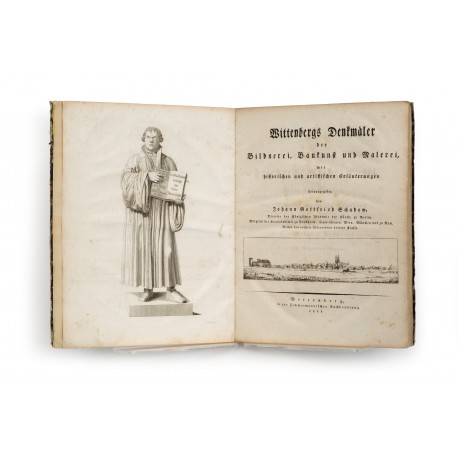Wittenbergs Denkmäler der Bildnerei, Baukunst und Malerei, mit historischen und artistischen Erläuterungen
- Subjects
- Archaeology, Medieval
- Germany - Description and travel
- Sculpture - Artists, German - Schadow (Johann Gottfried), 1764-1850
- Authors/Creators
- Schadow, Johann Gottfried, 1764-1850
- Artists/Illustrators
- Berger, Ferdinand, active 1825
- Schadow, Johann Gottfried, 1764-1850
- Printers/Publishers
- Rübner, active 1825?-1842?
- Zimmermann, active 1825?-1844
- Other names
- Luther, Martin, 1483-1546
Schadow, Johann Gottfried
Berlin 1764 – 1850 Berlin
Wittenbergs Denkmäler der Bildnerei, Baukunst und Malerei, mit historischen und artistischen Erläuterungen.
Wittenberg, Zimmermann (‘Gedruckt in der Rübenerschen Buchdruckerei in Wittenberg’), 1825
quarto (250 × 200 mm), (77) ff. signed π4 [1]–[18]4 (– [18]4, cancelled) 2π2 and paginated i–viii, 1–141(5), with engraved title-vignette (view of Wittenberg); plus engraved frontispiece (Schadow’s bronze statue of Luther in the Marktplatz, Wittenberg, signed Ferd. Berger sculp) and twenty-seven plates, engravings and lithographs, several with multiple figures on the sheet (as called for in appended ‘Table des Estampes représentant divers monumens de la ville de Wittenberg’),1 of which two are signed by Berger (Tab. E/F, 12), and others signed Gaspar fec (Tab. 16) and G. Schadow fecit (Tab. [P/Pp]).
provenance Hartung & Hartung, Auktion 115, Munich, 7 November 2006, lot 1085
Light spotting, occasional waterstaining, otherwise in good state of preservation.
binding early twentieth-century cloth-backed boards.
Only edition of an account of the artistic treasures of Wittenberg, compiled and partly-illustrated by the sculptor Schadow, who as his sight deteriorated had turned more to writing art theory and history and to graphic work (he was a proficient draughtsman, engraver, and lithographer).
The publication was the pretext for further celebrations of Schadow’s bronze statue of Luther, designed between 1802 (the date of a competition sponsored by the Vaterländische-Litterarische Gesellschaft der Grafschaft Mansfeld) and 1820, and unveiled in the Marktplatz in Wittenberg for the Reformationsfest on 31 October 1821.
A folding lithograph in this book by Schadow himself records the Luther statue from three sides (Tab. P–Pp);2 an anonymous engraving depicts it beneath the canopy made to Karl Friedrich Schinkel’s designs (Tab. O); and another by the Berlin printmaker Ferdinand Berger serves to introduce the volume (frontispiece; Fig. 1).
Schadow was active mainly as a portraitist and tomb sculptor and his attention is naturally focused here on the sculptural monuments in the Schlosskirche (Allerheiligen) and Stadtkirche (Marienkirche), particularly the tombs of the Askanian Elector Rudolf ii of Saxony (died 1370) and his wife Elisabeth, which are reproduced in an unsigned engraving by Schadow (Tab. g/G; Mackowsky, op. cit., no. 65); Peter Visscher’s bronze relief ‘Die Krönung Marias’, also engraved by Schadow (Tab. I; Mackowsky, op. cit., no. 64); Herman Vischer the elder’s bronze baptismal font decorated with figures of the Apostles, by an anonymous engraver; Peter Vischer the younger’s bronze tomb for the electoral prince Friedrichder Weise, and the tomb cast by Hans Vischer for Johann des Beständigen, reproduced on two plates by an anonymous engraver (Tab. A/B, C/D); alabaster statues of both rulers, engraved by Berger (Tab. E/F); Luther’s tomb (Tab. M), together with other monuments, and some details of architectural ornament.
Among the paintings reproduced are Lucas Cranach the elder’s famous altarpiece in the Stadtkirche (Tab. 13, 14/15, 16) and ‘Die Zehn Gebote’ in the Ratsstube im Rathaus (Tab. 7), Cranach the younger’s ‘Die Anbetung der Hirten’ (Tab. [10]), ‘Die Kreuzigung Christi’ (Tab. 9), and ‘Der Weinberg des Herrn’ (Tab. 12, signed by Berger), and portraits of Luther and Melanchthon taken from paintings by Cranach father and son in Wittenberg, Dresden, and Weimar (Tab. 8). An anonymous print of the room in the Augustiner-Kloster in which Luther dwelt, at first as a monk and in later life with his wife and family (Tab. 6), was engraved after a painting ‘von Herrn Hampe und befindet sich in der Sammlung des Herrn Banquier Wagner in Berlin’ (p.93).
Relevant to the preliminary historical narrative are four prints outside the lettered and numbered series: an anonymous lithograph depicting Luther standing in the door of the Schlosskirche as his 95 theses are being posted; another of Luther’s wine-jug, ‘auf der Konigl. Kunstkammer in Berlin… ausbewahrt’ (p.93); and two lithographs by Schadow, portraits of Peter Vischer and Lucas Cranach the elder (Mackowsky, op. cit., no. 96; Fig. 2), and an impressive self-portrait (Mackowsky, op. cit., no. 95; Fig. 3).3
references J.G. Graesse, Trésor de Livres Rares et Précieux (Dresden 1868), vi, p.295; Johann Gottfried Schadow. Kunstwerke und Kunstansichten: ein Quellenwerk zur Berliner Kunst- und Kulturgeschichte zwischen 1780 und 1845: Kommentierte Neuausgabe der Veröffentlichung von 1849, edited by Götz Eckhardt (Berlin 1987), pp.143, 287–291, 623–626; a facsimile was published at Halle: Fliegenkopf-Verlag, 1992
1. The twenty-eight plates are thus designated: [frontispiece], A/B, C/D, E/F, g/G, I, H/K/L/M/m, N/O, [P/pp], Q, 1/2, 3, 4, 5, 6, 7, 8, 9, 4 [i.e. 10], 11, 12, 13, 14/15, 16, ‘1517 den 31ten October’, [‘D. Martin Luthers Trink-Krug auf der Konigl. Kunstkammer zu Berlin. Nebst einer lithographierten Abbildung desselben’ pp.139–140], ‘Peter Fischer in seiner Gieshütte’/‘Lucas Cranach geboren 1472’, ‘Johann Gottfried Schadow’.
2. Hans Mackowsky, Schadows Graphik (Berlin 1936), no. 88. For the preparatory drawings, see Sibylle Badstübner-Gröger, Johann Gottfried Schadow. Die Zeichnungen (Berlin 2006), ii, nos. 1257–1259.
3. ‘... und abends in Verein’, Johann Gottfried Schadow und der Berlinische Künstlerverein 1814–1840, catalogue of an exhibition in Berlin Museum (Berlin 1983), pp.59, 61, no. 30; Johann Gottfried Schadow und die Kunst seiner Zeit, catalogue of an exhibition in Kunsthalle Düsseldorf, edited by Bernhard Maaz (Cologne 1994) p.247 no. 101. For the preparatory drawing, see Badstübner-Gröger, op. cit., i, no. 1310.








